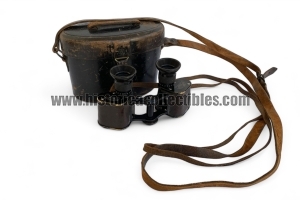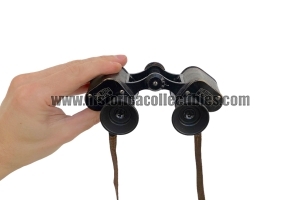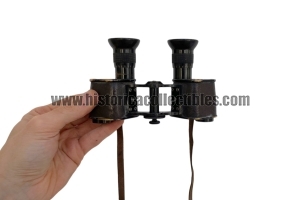Feldstecher 4-fach, Carl Zeiss Jena, circa 1904
This is the later version of one of the "older" Carl Zeiss Jena 4x binocular models. Its objective diameter is 14 mm (previous models had an aperture of 11 mm) and its magnification is 4x. This model of binoculars was produced from 1894 to 1908. During that period just under 4000 feldstechers of this type were released. These binoculars have eyepieces of the so-called "1/3" design (see Hans T.Seeger. Zeiss-Feldstecher, Handfernglaser von 1894-1919, Modelle-Merkmale-Mythos, p.116) with a base diameter of 20.5 mm and the width of the upper prismatic cover equal to 41 mm. Binoculars with this type of eyepiece were produced approximately from the end of 1902. Compared to the previous version of this model, the field of view of the binoculars was increased from 9.3° to 10.3°. The eyepieces have a diopter scale and transverse knurling. Binoculars of this type were produced from 1902 to 1908.
The hinge of the binocular frame is attached to its halves with the help of 5 screws on each side (previous models were attached with the help of 4 screws). The upper and lower covers of the prism are made of brass, the device has long "wings" for the shoulder strap, which are attached to the binoculars with the help of 2 screws (earlier models had shorter "wings", which were fixed with l the help of a single screw). On the left plate there is the "Carl Zeiss, Jena" logo, while on the right "Feldstecher 4 Fach", where Feldstecher stands for "Binoculars" and 4 Fach is the abbreviation of "Facher" (Times), understood as enlargements (word used in the first years of production of Zeiss binoculars). Based on the four-digit serial number "2XXX" and the structure of the binoculars (eyepiece joint, mount attachment hinge), it can certainly be said that the binoculars were produced approximately in 1904.
The binoculars are in perfect working order in all their parts and the view is collimated and clear.
Carl Zeiss takes its name from its founder, Carl Zeiss, who on November 17, 1846 chose the small city of Jena, in Thuringia, as the location for his precision optical equipment factory. Thanks to the strict quality control that Carl Zeiss imposed on its products, going so far as to personally destroy the microscopes that did not pass the tests, the newborn Zeiss became the official supplier of the University of Jena and received the gold medal of the industrial exhibition in 1861 of Thuringia as the best research instrument manufactured in Germany, awarded to the microscope Stand I of 1857.
In 1866, the thousandth microscope was produced and the Zeiss name became known in all European scientific circles. Thanks to the studies on the Porro prism, in 1893 Abbe patented a double prism binoculars, which accentuated the perception of depth.
The mass production of Zeiss binoculars began in 1894, already at the beginning of the twentieth century more than 30,000 were made, by the beginning of the First World War the figure had risen to 500,000 and, by the end of the Second World War, 2,260,000 were produced binoculars for the civilian and military market. Models were made starting from 4x11 mm to 12x40 mm, up to real giants such as 80 mm and 100 mm.
Thanks to studies conducted on the perception of light in low light situations, it was shown that the average dilation of the pupil in an adult is about 7 mm. For this reason, the 7x50 mm model was introduced in 1910 and remained on the market until 1917 with few changes to the materials used.
In 1926, following the post-war crisis of the First World War with the Treaty of Versailles which bankrupted many important German companies, Zeiss bought the "C.P. GOERZ" and founded the Zeiss Ikon in 1926.
In 1937, Zeiss had commercial contacts and factories spread over 29 countries around the world. From 1933 Zeiss acquired interest from the Nazi regime, which balanced production towards military instruments. It successfully produced binoculars with wide-angle optics for military use, pressure resistant optical systems for U-boats, periscope binoculars for targeting tanks. Furthermore Zeiss cameras were mounted on the V2 for remote sensing operations of the English coasts.
On November 1, 1935, Zeiss, in the person of Alexander Smakula, patented a process for the treatment of optical glasses with extraordinary results in terms of light transmission. Remained a military secret until 1939, it was adopted on binoculars to reduce ghost images and internal reflections. During the Second World War, there were numerous bombings against the Zeiss factories.
Jena was bombed several times by the Allies starting in 1944. Stuttgart was razed to the ground, although the Contessa-Nettel factory suffered little damage. The bombing of Dresden, in addition to devastating the city, also caused considerable damage to the Zeiss Ikon headquarters.
On April 13, 1945, American military forces entered Jena, surprising themselves as the bombings had not caused significant damage. The main planetarium was in ruins, while the factories remained operational.




